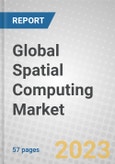Report Scope
The current report offers a detailed picture of the global spatial computing market. This report highlights the current and future market potential for spatial computing and provides a detailed analysis of the competitive environment, process, relationship of metaverse to spatial computing, drivers, restraints, opportunities, and trends in the market, emerging technologies, and regulatory framework. The report also covers market projections through 2028 and key market players. This report discusses spatial computing and its various resources. It covers the overall spatial computing market, including offering, technology, and industry. Furthermore, a complete regional analysis of the market is also presented in the report. Based on offering the market has been categorized into hardware, software, and services. Based on technology, the spatial computing market has been segmented into AR, VR, MR, Internet of Things (IoT), Artificial Intelligence, and others.The market has been segmented based on geography into North America, Europe, Asia-Pacific, and the Rest of the World (including Latin America, the Middle East, and Africa). Detailed analyses of major countries (the U.S., Canada, Germany, the UK, France, Italy, Japan, China, and India) are covered in regional segments. For market estimates, data has been provided for 2022 as the base year, with forecasts for 2023 through 2028. Estimated values are based on revenue from spatial computing companies as total revenues. Projected and forecasted revenue values are in constant U.S. dollars that have not been adjusted for inflation.
Report Includes
- An overview and in-depth analysis of the global spatial computing market
- Analyses of the global market trends, with historical market revenue data (sales figures) for 2022, estimates for 2023, forecasts for 2024, and projections of compound annual growth rates (CAGRs) through 2028
- Estimate of the actual market size and revenue forecast for the global spatial computing market, and corresponding market share analysis based on offering, technology, industry, and region
- Overview of the significant driving trends and challenges that affect the global market and its vendor landscape
- Discussion of sustainability trends and factors in the market for spatial computing, with emphasis on consumer attitudes, ESG score analysis, future of ESG, case study, and the ESG practices followed
- Analysis of the company competitive landscape based on their recent developments, key financials and segmental revenues, and product offerings
- Profiles of the leading market players
Table of Contents
Chapter 1 Introduction
Chapter 2 Summary and Highlights
Chapter 3 Market Overview
Chapter 4 Market Breakdown by Offering, Technology and Industry
Chapter 5 Market Breakdown by Region
Chapter 6 Sustainability in the Spatial Computing Industry: An ESG Perspective
Chapter 7 Competitive Landscape
Chapter 8 Company Profiles
List of Tables
List of Figures
Executive Summary
The goals and objectives of this study are to
- Define the global spatial computing market.
- Analyze the market by offering, technology and industry.
- Estimate the market revenues for the spatial computing market by region.
- Identify market drivers, restraints, and opportunities in the market.
- Analyze the competitive landscape.
- Provide profiles of the major players and their product portfolios.
Companies Mentioned
- Apple Inc.
- Epic Games Inc.
- Google Llc
- Htc Corp.
- Intel Corp.
- Magic Leap Inc.
- Meta Platforms Inc.
- Microsoft Corp.
- Nvidia Corp.
- Qualcomm Technologies Inc.
- Sony Corp.
- Unity Software Inc.
- Varjo Technologies Oy
- Vuzix Corp.








